




Your support is critical to our success.
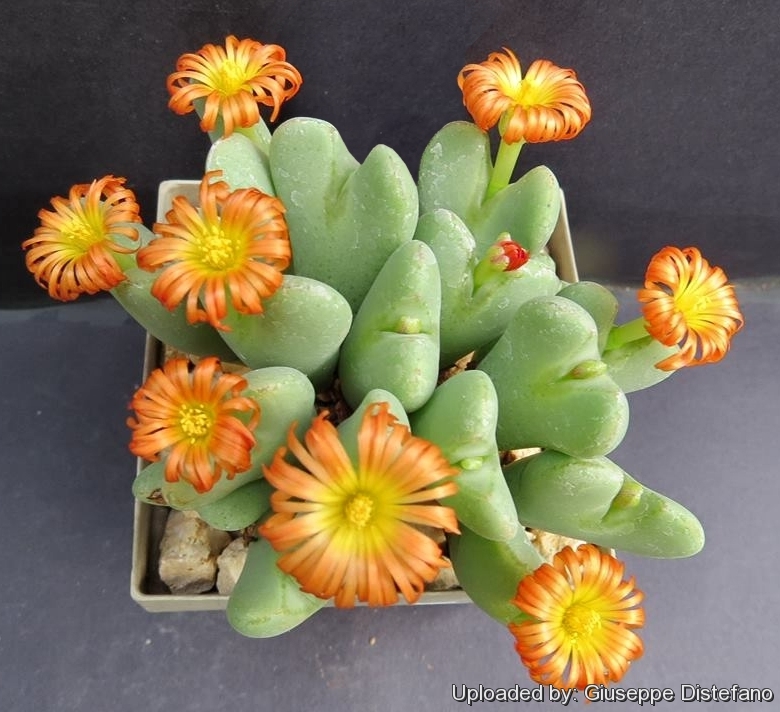
Origin and Habitat: Northern Cape, Namaqualand (Provincial distribution Komaggas to Kourkammaberg just on the eastern edge of the coastal plain ), South Africa.
Habitat and Ecology: It grows in Succulent Karoo on wet exposed quartzite slopes. It is a locally abundant, but range-restricted species (Extent of occurrence less than 100 km²) that is not threatened. The area seems to support a fairly lush vegetation comprising unusual geophytes like Massonia depressaSN|33427]]SN|33427]] and Eriospermum aphyllum, a tuber with photosynthetic stems branched like an old rooftop TV antenna.
Synonyms:
- Conophytum frutescens Schwantes
Conophytum frutescens Schwantes
Möller's deutsche gärtner-zeitung 42: 123 1927
Synonymy: 4
- Conophytum frutescens Schwantes
- Conophytum notabile N.E.Br.
- Conophytum salmonicolor L. Bolus
- Conophytum teguliflorum Tischer
RUSSIAN (Русский): Конофитум кустарниковый
Description: Conophytum frutescensSN|1166]]SN|26018]] Schwantes sometimes listed under its old name of Conophytum salmonicolorSN|26020]]SN|26020]], which well describes the beautiful orange-pink or orange/coppery flowers. The orange mid-day flowers are also quite unusual: similar coloration only otherwise occurs in conophytums with nocturnal blooms, or in hybrids between species with violet petals and species with yellow petals.
Habit: It is a very attractive slow-growing, perennial succulent 10-30(-50) cm tall, named for its unequalled shrubbiness. It forms loose, spherical shrublets of bodies like that of C. bilobum in shape.
Stems: In a genus known for compact and sometimes even largely subterranean growth, C. frutescens produces laxly branched stems with extended internodes up to 3 cm long, though this feature is lacking in some northern populations.
Note: This plant can also be distinguished from the tall forms of Conophytum bilobumSN|26018]]SN|1166]] by its very peculiar flowers colouration and aberrant flowering season (spring to summer).
Bodies (Paired leaves): to 35 mm tall, 15 mm wide, are flat, more than half fused, claw-shaped, slit which gapes open, and the two lobes are rather prominent, yellowish-green, grey-green, or turquoise, glabrous, spotted, marked with dully purple streaks or patches on the keels and on edge of fissure between the lobes. Between the two leaf tips of each fused pair, the dried out remains of flowers from the previous season are visible.
Flowers: Orange to coppery or pinkish. Ovaries included. Calyx tube 5 mm long, with 5 narrow, 5 mm long, pale green, translucent lobes. Corolla tube 1.2-1.4 cm. long, up to 1.5 mm wide, narrow lanceolate, tip slightly incurved, inner narrower and shorter.
Blooming season: It is one of the earliest to flower. Most conophytums have autumn flowers, but C. frutescens is in full bloom at the summer solstice.
Fruits: 4-5-locular.
Bibliography: Major references and further lectures
1) Victor, J.E. 2006. Conophytum frutescens Schwantes. National Assessment: “Red List of South African Plants” version 2013.1. Accessed on 2014/01/29
2) Nicholas Edward Brown, A. Tischer, M. C. Karsten “Mesembryanthema; Descriptions: With Chapters on Cultivation and General Ecology” L. Reeve, 1931
3) Gordon D. Rowley “The illustrated encyclopedia of succulents” Crown Publishers, 01/Aug/1978
4) James Cullen, Sabina G. Knees, H. Suzanne Cubey “The European Garden Flora Flowering Plants: A Manual for the Identification of Plants Cultivated in Europe, Both Out-of-Doors” Cambridge University Press, 11/Aug./2011
5) Hammer, S. 1993. “The Genus Conophytum - A Conograph.” Succulent Plant Publications, Pretoria.
6) Hammer, S. 2002. “Dumpling and His Wife: New Views of the Genus Conophytum.” East Anglia Engraving Creative Colour Ltd, Norwich, England.
7) Ernst Van Jaarsveld, Ben-Erik Van Wyk, Gideon Smith “Succulents of South Africa: A Guide to the Regional Diversity” Tafelberg Publishers, Limited, 01/lug/2000
8) Heidrun E.K. Hartmann “Illustrated Handbook of Succulent Plants: Aizoaceae A-E” Springer, 2002
9) Werner Rauh “The Wonderful World of Succulents: Cultivation and Description of Selected Succulent Plants Other Than Cacti” Smithsonian Institution Press, 1984
10) Hermann Jacobsen “Lexicon of Succulent Plants” Littlehampton Book Services Ltd. 1974
11) Christopher Brickell “RHS Encyclopedia of Plants and Flowers” Dorling Kindersley Ltd, 01/set/2010
12) William Davidson “The illustrated directory of house plants: a practical guide to growing over 500 plants for the home” Salamander, 01/nov/1990
13) Vera Higgins “Succulent Plants Illustrated” Blandford Press, 1949
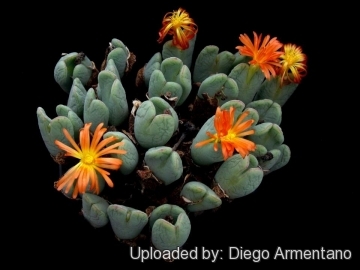
Conophytum frutescens Photo by: Diego Armentano
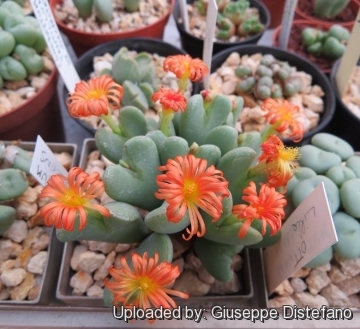
Conophytum frutescens Photo by: Giuseppe Distefano
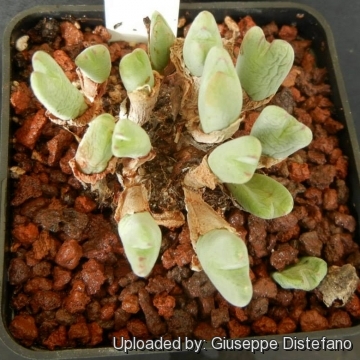
Conophytum frutescens Photo by: Giuseppe Distefano
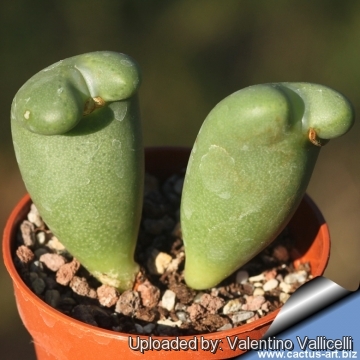
Conophytum frutescens Photo by: Valentino Vallicelli
Cultivation and Propagation: Conophytum frutescensSN|26018]]SN|26018]] is an opportunistic grower which is most active from late winter until later summer and not heading for summer dormancy. In in favourable growing conditions it keeps going over the summer too and doesn't need particular care. It is easy to grow.
Soil: Requires good drainage as it it is prone to root rot. It can grows outdoor in sunny, dry, rock crevices (protection against winter wet is required) It can also be cultivated in alpine house, in poor, drained soil.
Watering: It requires little water; otherwise its epidermis breaks (resulting in unsightly scars). Water minimally in winter, (only when the plant starts shrivelling). Water moderately in winter after the previous year's leaves have dried up. Requires good drainage.
Fertilization: Feed it once during the growing season with a fertilizer specifically formulated for cactus succulents (poor in nitrogen), including all micro nutrients and trace elements diluted to ½ the strength recommended on the label. It thrives in poor soils and need a limited supplies of fertilizer to avoid the plants developing excess vegetation, which is easily attacked by fungal diseases.
Exposure: Keep cool and shaded in summer, it needs full sun or light shade.
Temperature: Hardy to -2°C. Ensure a very good ventilation.
Repotting: Avoid to repot frequently. This plant may stay in the same pot for many years.
Uses: Container, rock garden.
Pests and diseases: It is vulnerable to mealybugs and rarely scale.
Propagation: It can be reproduced both by cuttings and seeds. Take the cutting from a grown-up mother plant. Each cutting must contain one or more heads along with a fraction of root. It is easily propagated by seed. The small seeds can be sown in pots of fine, well-drained sand, any time during the spring and summer months when temperatures are warm. Cover the seeds with a very fine layer of grit and water from below with a fungicide to prevent damping off. For the first 3-4 days cover the pots with a sheet of glass/clear perspex to keep the humidity levels high. Remove the glass and replace it with light shadecloth and mist once or twice a day for the next two weeks after which most seeds should have germinated. From then on mistings can be reduced to every second and then every third day as the little plants grow.
| Your Actions | |
|---|---|
| Back to Conophytum index | |
| Back to Aizoaceae index | |
 |
Back to Succulents Encyclopedia index |
Privacy stantement - Terms and conditions - How to cite - About us - Feedback - Donate



